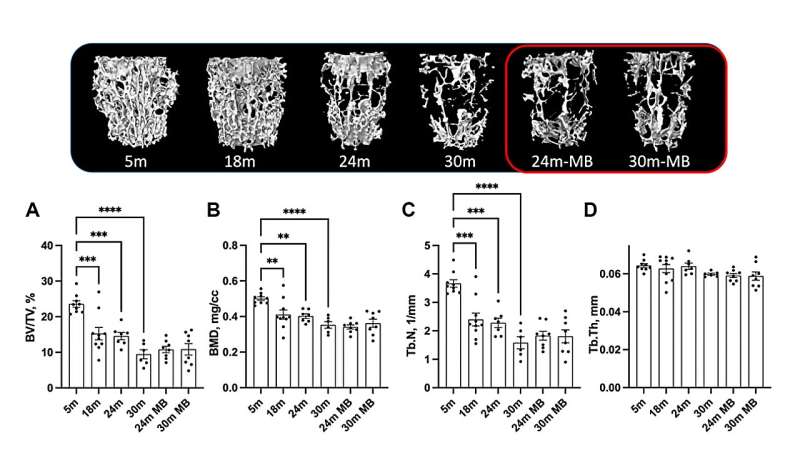Administration of MB during aging does not alter trabecular bone morphology of the axial skeleton. Credit: Aging (2024). DOI: 10.18632/aging.205147
A new research paper titled "Targeting mitochondrial dysfunction using methylene blue or mitoquinone to improve skeletal aging" has been published in Aging.
Methylene blue (MB) is a well-established antioxidant that has been shown to improve mitochondrial function in both in vitro and in vivo settings. Mitoquinone (MitoQ) is a selective antioxidant that specifically targets mitochondria and effectively reduces the accumulation of reactive oxygen species. In this new study, researchers from New York University College of Dentistry, City College of New York, The Jackson Laboratory, University of Michigan, South Texas Veterans Health Care System, and The University of Texas Health Science Center investigated the effect of long-term administration of MB or MitoQ on skeletal morphology during the aging process.
"[...] we administered MB to aged (18 months old) female C57BL/J6 mice, as well as to adult male and female mice with a genetically diverse background (UM-HET3). Additionally, we used MitoQ as an alternative approach to target mitochondrial oxidative stress during aging in adult female and male UM-HET3 mice," the researchers write.
Although the researchers observed some beneficial effects of MB and MitoQ in vitro, the administration of these compounds in vivo did not alter the progression of age-induced bone loss. Specifically, treating 18-month-old female mice with MB for 6 or 12 months did not have an effect on age-related bone loss. Similarly, long-term treatment with MB from 7 to 22 months or with MitoQ from 4 to 22 months of age did not affect the morphology of cortical bone at the mid-diaphysis of the femur, trabecular bone at the distal-metaphysis of the femur, or trabecular bone at the lumbar vertebra-5 in UM-HET3 mice.
The team concludes, "Based on our findings, it appears that long-term treatment with MB or MitoQ alone, as a means to reduce skeletal oxidative stress, is insufficient to inhibit age-associated bone loss. This supports the notion that interventions solely with antioxidants may not provide adequate protection against skeletal aging."
More information: Sher Bahadur Poudel et al, Targeting mitochondrial dysfunction using methylene blue or mitoquinone to improve skeletal aging, Aging (2024). DOI: 10.18632/aging.205147
Provided by Impact Journals LLC























